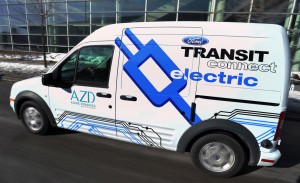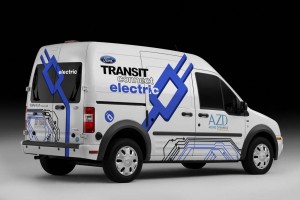You might miss the little white van, hidden in the back of a nondescript warehouse in the Detroit suburb of Oak Park, but it could kick off a significant revolution in the years ahead.
Later this month, the first 29 of those vans – or more precisely, those Transit Connect Electric vans – will begin to roll out of that warehouse, 14 of them heading for fleet tests in the U.K., the rest going to fleets here in the U.S.
The Transit Connect Electric is one of two battery-electric vehicles that Ford plans to bring to market in the next couple years, the other model being a lithium-powered version of the next-generation Focus. The program has been pushed back a bit, at least in terms of retail sales, giving the maker a bit more opportunity to test the new models under more controlled fleet conditions.
The Detroit maker has taken an unusually entrepreneurial approach to its initial battery car efforts, turning to two outside suppliers to help it get to market more quickly. The Canadian mega-supplier, Magna, is taking the lead role in developing the Focus Electric, while another Canadian firm, Azure Dynamics, is spearheading the Transit Connect battery van project.
“We can do it quicker and for less money,” explained Azure Dynamics Chief Operating Officer Curt Huston, during an interview at the firm’s suburban Detroit facility. The firm takes “gliders,” versions of the Transit Connect produced without a powertrain, and installs its own electric driveline.
The company has a long history in the electric vehicle world. A spin-off of the University of Vancouver, it acquired Selectria, one of the pioneers of the technology, in 2005. But AD has shifted focus from electric passenger cars to light and medium-duty trucks, both hybrids and pure battery-electric vehicles, or BEVs.
The logic, Huston contends, is simple. While it will take some time to convince consumers of the merits of electric propulsion – overcoming concerns about range and cost – it’s an easier sell to fleet buyers. They have precise and well-defined needs and are likely to live within the limited range of today’s batteries which, in the case of the Transit Connect Electric’s lithium-ion pack, is 80 miles per charge.
(General Electric will purchase 25,000 battery cars, including 12,000 Chevy Volts. Click Here for more.)
Using a 220-volt “Level II” charger, the battery version of the Transit van would be ready to get back on the road in 6 to 8 hours, while it would only need be out of service about 60 minutes, according to Huston, using a high-speed, 440-volt charging station, something likely to become common in fleet depots.
The biggest near-term challenge will be cost. Ford and Azure Dynamic officials decline to discuss the price, which they insist has not yet been finalized, but they expect it could come down sharply, in the next few years. The key is the rapid increase in production capacity for lithium batteries as more competitors enter the field. Huston says that is being spurred by a $2.5 billion grant program launched by the Obama Administration to encourage the electrification of the auto industry.
“No doubt about it,” said Huson, that “push is driving down lithium-ion costs quickly.”
As recently as a year ago, it was generally assumed that LIon technology cost about $1,000 per kilowatt/hour. That’s a significant burden for a vehicle like the Transit Connect Electric, which uses 28 kWh of batteries. But industry insiders now believe that could reach as little as $300 to $400 per kWh by mid-decade, something Huston cautiously describes as a “reasonable estimate,” based on current trends.
A brief drive of the Transit Connect Electric reveals few, if any compromises in the performance of the vehicle, other than range. In fact, the battery version of the European-made van is quicker off the line than the gasoline-powered Transit Connect. But acceleration slows considerably at highway speeds.
In terms of functionality, the battery pack is hidden below the load floor and AD engineers were able to conceal it with only the most modest intrusion into the Ford van’s normal cargo space.
The initial fleet test will be followed by limited retail sales, beginning in 2011. Azure Dynamics will serve as the van’s maker of record, but service will be available through Ford dealers in the U.S. and abroad.
The company’s Lead Customer Program has already lined up 93 orders, including at least 10 each from AT&T, Johnson Controls – a major automotive supplier – and Canadian Post. Several utilities, including Southern California Edison, have also placed orders, and the AD is talking with a number of other utilities and fleet operators, including the U.S. Postal Service, which utilizes more than 120,000 small vans and delivery vehicles, and which is under pressure to migrate to “green” technology.
The potential for a booming fleet market was underscored by Jeff Immelt, the CEO of General Electric, who earlier this month announced plans to purchase “tens of thousands” of battery vehicles for his sales and service staff. GE has so far declined to identify what products it will purchase.
As the Transit Connect Electric gets beyond the fleet test stage, Azure Dynamics COO Huston says the target range will be around 800 to 1200 of the battery vans annually.


